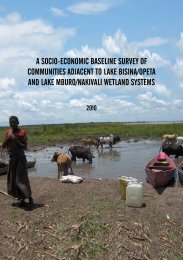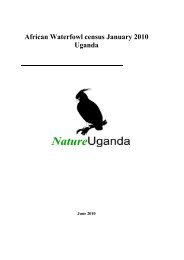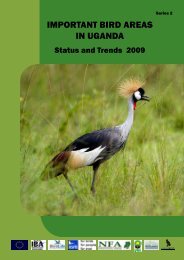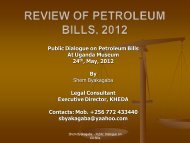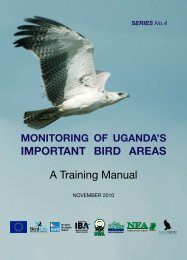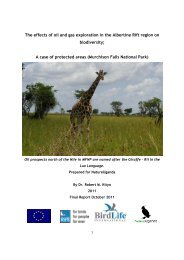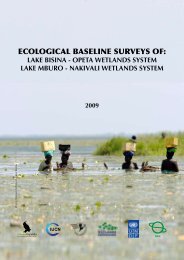the economic valuation of the proposed ... - Nature Uganda
the economic valuation of the proposed ... - Nature Uganda
the economic valuation of the proposed ... - Nature Uganda
You also want an ePaper? Increase the reach of your titles
YUMPU automatically turns print PDFs into web optimized ePapers that Google loves.
The Economic Valuation <strong>of</strong> <strong>the</strong> Proposed Degazettment <strong>of</strong> Mabira CFR<br />
___________________________________________________________________________________<br />
Figure 2: 2: Key Key Elements <strong>of</strong> <strong>the</strong> <strong>of</strong> Conservation <strong>the</strong> Conservation versus Degazettement versus Degazettment Options Options <strong>of</strong> Part <strong>of</strong> <strong>of</strong> Mabira Part Central<br />
Forest <strong>of</strong> Mabira Reserve Central Forest Reserve<br />
1.4. METHODOLOGY<br />
This <strong>economic</strong> analysis was carried out in three phases including a detailed review <strong>of</strong><br />
1.4. METHODOLOGY<br />
literature and media reports on <strong>the</strong> subject, assessment <strong>of</strong> standing stock and inventory<br />
This <strong>economic</strong> analysis was carried out in three phases<br />
information on <strong>the</strong> potential impact on <strong>the</strong> forest, key informant interviews, community<br />
including<br />
consultations<br />
a detailed<br />
followed<br />
review<br />
by<br />
<strong>of</strong><br />
data<br />
literature<br />
computations<br />
and media<br />
and interpretation. The study also involved<br />
reports detailed on <strong>the</strong> description subject, assessment <strong>of</strong> <strong>the</strong> biodiversity <strong>of</strong> standing stock <strong>of</strong> Mabira Central Forest Reserve, <strong>economic</strong><br />
and e<strong>valuation</strong> inventory <strong>of</strong> information <strong>the</strong> agricultural on <strong>the</strong> potential impact <strong>of</strong> <strong>the</strong> area and detailed analysis <strong>of</strong> <strong>the</strong> sugar<br />
on commodity <strong>the</strong> forest, market. key informant interviews, community<br />
Description <strong>of</strong> <strong>the</strong> biodiversity <strong>of</strong> Mabira CFR relied on literature reviews. The<br />
agricultural <strong>economic</strong> e<strong>valuation</strong> relied on both budgeting techniques and cost benefit<br />
analysis, using <strong>the</strong> Net Present Value as <strong>the</strong> decision-making<br />
chapters.<br />
criteria. Assessment <strong>of</strong> <strong>the</strong><br />
conservation value <strong>of</strong> <strong>the</strong> forest estate relied on both cost benefit analysis and <strong>the</strong><br />
concept <strong>of</strong> total <strong>economic</strong> value (TEV). The detailed analytical frameworks are<br />
described in subsequent chapters.<br />
____________________________________________________________________<br />
By Yakobo Moyini, PhD<br />
6<br />
Biodiversity<br />
Conservation<br />
Down stream<br />
water services<br />
Recreation<br />
Extraction <strong>of</strong><br />
forest products<br />
Cost <strong>of</strong><br />
conservation<br />
Net decrease in<br />
ecosystem benefits<br />
Biodiversity<br />
Conservation<br />
Down stream<br />
water services<br />
Recreation<br />
Extraction <strong>of</strong><br />
forest products<br />
Decreased<br />
Biodiversity<br />
Conservation<br />
Decreased Down<br />
stream water<br />
services<br />
Decreased<br />
Recreation<br />
Reduced Extraction<br />
<strong>of</strong> forest products<br />
Less foregone cost<br />
<strong>of</strong> conservation<br />
Gross<br />
decrease in<br />
ecosystem<br />
benefits<br />
Opportunity<br />
cost <strong>of</strong><br />
foregone<br />
ecosystem<br />
benefits<br />
Cost <strong>of</strong><br />
conservation<br />
With Conservation Without Conservation Cost benefit analysis <strong>of</strong> conservation<br />
Source: Pagiola et al., (2004)<br />
decision<br />
consultations followed by data computations and<br />
interpretation. The study also involved detailed<br />
description <strong>of</strong> <strong>the</strong> biodiversity <strong>of</strong> Mabira Central Forest<br />
Reserve, <strong>economic</strong> e<strong>valuation</strong> <strong>of</strong> <strong>the</strong> agricultural<br />
potential <strong>of</strong> <strong>the</strong> area and detailed analysis <strong>of</strong> <strong>the</strong> sugar<br />
commodity market.<br />
Description <strong>of</strong> <strong>the</strong> biodiversity <strong>of</strong> Mabira CFR relied on<br />
literature reviews. The agricultural <strong>economic</strong> e<strong>valuation</strong><br />
relied on both budgeting techniques and cost benefit<br />
analysis, using <strong>the</strong> Net Present Value as <strong>the</strong> decisionmaking<br />
criteria. Assessment <strong>of</strong> <strong>the</strong> conservation value <strong>of</strong><br />
<strong>the</strong> forest estate relied on both cost benefit analysis and<br />
<strong>the</strong> concept <strong>of</strong> total <strong>economic</strong> value (TEV). The detailed<br />
analytical frameworks are described in subsequent<br />
The Economic Valuation <strong>of</strong> <strong>the</strong> Proposed Degazettement <strong>of</strong> Mabira CFR | 2011<br />
7



